Side Menu:
Fifth Officer Harold Lowe
- Evacuation
When Lowe's shift finished at 8pm he "went to bed at about anywhere between a quarter past 8 and half past 8." (US Inquiry, Day 5) According to a later account, when he went off duty at 8 the weather was fine and clear. There was no haze. ("The Third Titanic Inquiry - Ryan v. OSNC Transcript of Precis Law Report," Encyclopedia Titanica)
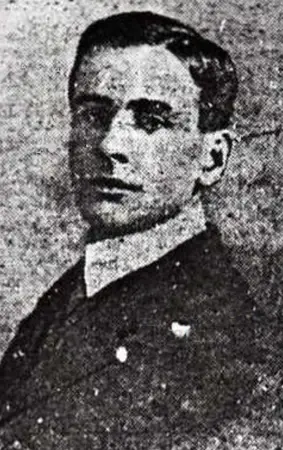
Lowe never heard Fourth officer Boxhall tell
him they had struck an iceberg as he was
fast asleep.
Famously, Lowe described the four hours on and four hours off sheet as being such that "when we sleep we die." (US Inquiry, Day 5). For this reason, he explained when Titanic made contact with an iceberg he "never felt anything." He also did not remember being awakened by Fourth Officer Boxhall: "Mr. Boxhall, the fourth officer, told me that he told me that we had struck an iceberg, but I do not remember it... It must have been while I was asleep. You must remember that we do not have any too much sleep and therefore when we sleep we die." (US Inquiry, Day 5)
But he was disturbed by noise in the officer's quarters, which were normally off limits for passengers:
"I was half awakened by hearing voices in our quarters, because it is an unusual thing, and it woke me up. I suppose I lay down there for a little while until I fully realised, and then I jumped out of bed and opened my door a bit and looked out, and I saw ladies in our quarters with lifebelts on….As soon as I looked out through the door I jumped back and got dressed and went out on deck, and the boats were being cleared." (British Inquiry)
He was not only disturbed by the passengers but also by the fact he noticed Titanic was already down by the bow:
I was awakened by hearing voices, and I thought it was very strange, and somehow they woke me up and I realized there must be something the matter; so I looked out and I saw a lot of people around, and I jumped up and got dressed and went up on deck…I found that all the passengers were wearing belts…I also found that they were busy getting the boats ready to go overboard…I met somebody, and they said she had struck an iceberg, and I could feel by my feet that there was something wrong…It is not listing; it is tipping... She was by the bow; she was very much by the bow. She had a grade downhill... I should say she was about 12° to 15° by the head. (US Inquiry, Day 5)
Lowe's first action was to retrieve his firearm: "I first of all went and got my revolver...you never know when you will need it. "(US Inquiry, Day 5). Although it seems more likely he retrieved it slightly later when he was loading the lifeboats. Next he saw the Captain: "I saw the captain... just after I got out of bed. (US Inquiry, Day 5).
Lifeboats
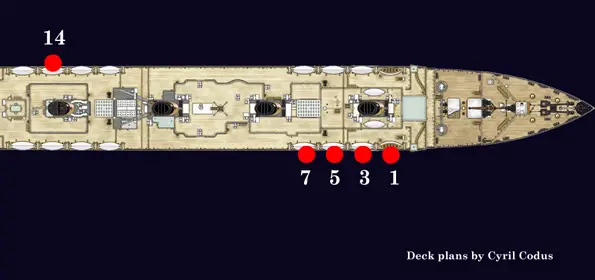
The approximate sequence of lifeboats lowered by Lowe is as follows:
|
Time |
Lifeboat |
Occupants |
Launched by |
In charge |
|
12.40am |
No.7 |
34 |
Murdoch/Lowe |
Lookout George Hogg |
|
12.45am |
No.5 |
36 |
Murdoch/Pitman/Lowe |
Third Officer Pitman |
|
12.55am |
No.3 |
32 |
Murdoch/Lowe |
Able Bodied Seaman George Moore |
|
1:05am |
No.1 |
12 |
Murdoch/Lowe |
Lookout George Symons |
1:25am |
No.14 |
45 |
Wilde/Lightoller/Lowe |
Fifth Officer Lowe |
In his US testimony, Lowe stated his lifeboat station was no.11, starboard side (US Inquiry, Day 5) although he later said at the British Inquiry he did not know which lifeboat he was assigned to.
According to Lowe it took about 10 men to lower a lifeboat: "It takes 2 at each winch. Then there were 2 jumped in each boat. Then there were some clearing the falls - that is, the ropes - and you can roughly estimate it at 10 men." As for the time to lower a lifeboat "from the start to finish of putting a boat over, until you get her into the water, it will take you somewhere about 20 minutes."(US Inquiry, Day 5) The davit worked exactly as expected: "Everything went all right, sir, and it could not have been worked better…With perfect safety.""(US Inquiry, Day 5)
As for passengers he "simply shouted, "Women and children first; men stand back."…Regardless of class, or nationality, or pedigree….I distinctly remember saying "One more woman," or "Two more women," or "Three more women," and they would step forward and I would pass them into the boat.(US Inquiry, Day 5)
In regards to the number Lowe put into the lifeboat before lowering he later said: "That depends upon the caliber of the man lowering her…It depends upon the gear also, sir. You will say to yourself, "I will take the chance with 50 people in this boat." Another man will say, "I am not going to run the risk of 50; "I will take 25 or 30…The dangers are that if you overcrowd the boat the first thing that you will have will be that the boat will buckle up like that [indicating] at the two ends, because she is suspended from both ends and there is no support in the middle…I should not like to put more than 50 in."(US Inquiry, Day 5)
Lowe noted that it was not about his "calibre" but "Upon Mr. Murdoch." When it was pointed out to Lowe by Senator Smith that Lightoller on the other side had frequently lower than 50 in his lifeboats when lowered Lowe said: "I am different from another man. I may take on more risk, we will say, than you; or you may take on more risk than me."(US Inquiry, Day 5)
Gangway Doors
As also mentioned by Second Officer Lightoller during his testimony, there seemed to be a plan to use a gangway door once the lifeboat had been lowered into the water:
I was working on the idea that the gangway doors were going to be opened and take people from there…Certainly; we were not going to load the boat with its floating capacity from the davits….I told them to haul off from the ship’s side, but to remain within hail. That is what I told each of them with the exception of the boat that Mr. Pitman went in." (British Inquiry)
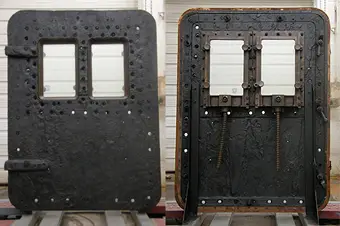
Port-side gangway door from the Titanic’s D-Deck
recovered from the wreck site. Image: Evergreene.com
(Click image to enlarge) (49.)
It is quite possible that Lowe heard this plan from Lightoller: "I must have overheard it…. I overheard a conversation somewhere referring to the gangway doors being opened, and that the boatswain and a crowd of men had been sent down there." (British Inquiry)
Generally speaking the lifeboat evacuation was efficient -"no ship could have done it in better time, and better in all respects - in every respect." (British Inquiry) but also peaceful:
Everything was quite quiet and calm. The only thing - and of course you would expect that - was that the people were messing up the falls, getting foul of the falls, and I had to halloa a bit to get them off the falls. Everything else went nicely; quietly and orderly…There was no such thing as selecting. It was simply the first woman, whether first class, second class, third class, or sixty-seventh class. It was all the same; women and children were first. (US Inquiry, Day 5)
The only issue Lowe expressed was in finding a "boatman" - someone who could handle a boat at sea:
A sailor is not necessarily a boatman; neither is a boatman a sailor, because they are two very different callings. I might pride myself that I am both - both a sailor and a boatman. A sailor may go to sea for quite a number of years and never go into a boat, never touch an oar, whereas you put a boatman in a ship and put him to do a job, and he is useless. He does not know anything about it. That is trying to convert a boatman into a sailor. They are both very different callings. That is the reason why many of the sailors could not row." When asked by the Senator why experienced boatman were not used he explained "You could not run around asking who could row - "Can you row? Can you row?"…I never asked anybody else whether they could handle a boat. (US Inquiry, Day 5)
This lack of men to man the lifeboats properly was also possibly due to the gangway doors plan:
"A crowd of men went down with the boatswain to clear away the gangway doors in the hope that we should be able to find people down there when we had lowered the boats down…The discipline could not have been better, and what I mean to say is that you must remember that we did not have one boat to lower away; we had and we put 19 over, and when you come to split up 16 men between 19 boats, you have not got many men to juggle with. Then they are all scattered all over the place…there was a crowd went down to the gangway doors to get them open and we were going to load the boats and take passengers from these gangway doors..(US Inquiry, Day 5)
12.40am Lifeboat No.7
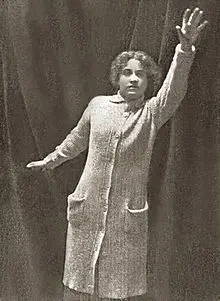
Dorothy Gibson in a promotional
photo for Saved From the Titanic (1912),
dressed in the same clothes that she
wore the night of the sinking
(Click image to enlarge)
"I had to go round the port side first, that is on my way to the starboard…. I came round abaft the second funnel….The first boat I went to was No. 7." (British Inquiry)
However at the Senate Inquiry a month earlier he mis-remembered his first lifeboat as being no.5:
"Then I went and helped everybody all around. Let us see; I crossed over to the starboard side. I lowered away. The first boat I helped to lower was No. 5, starboard boat. I lowered that boat away…under the orders of Mr. Murdoch... He was superintending that deck…He was in charge of everything there...Mr. Murdoch was running the show.(US Inquiry, Day 5)
Lifeboat No.7, the first lifeboat to depart Titanic, had three crew men consisting of Lookouts Hogg and Jewell and Seaman William Weller and 25 passengers, mostly from first class, including 22 year-old actress Dorothy Gibson, Pierre Maréchal, French aviator and father of the racing driver Jean-Pierre Maréchal, and Margaret Hays, New York heiress also brought her dog named Lady into the lifeboat.
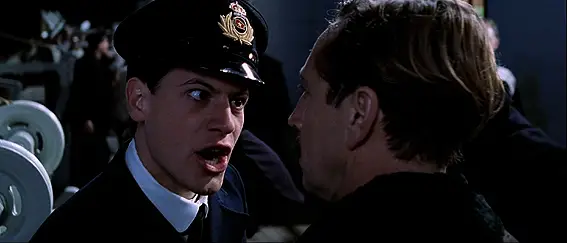
Fifth Officer Lowe (Ioan Gruffudd) telling Bruce Ismay not to interfere in a deleted scene from James Cameron's 1997 film "Titanic". (Click image to enlarge)
12.45am Lifeboat no.5 and Mr Ismay
Only minutes after lifeboat 7 departed, lifeboat no.5 was being loaded and lowered. On Day 5 of the Senate Inquiry Lowe later admitted voluntarily to swearing at the White Star Line President Bruce Ismay during this process:
"I ordered Mr. Ismay away from the boat…This was on the starboard side. I don't know his name, but I know him by sight. He is a steward. He spoke to me on board the Carpathia. He asked me if I knew what I had said to Mr. Ismay. I said, "I don't know Mr. Ismay. "Well," he said, "you used very, very strong language with him." I said, "Did I?" I said, "I can not help it if I did." He said, "Yes, you did," and he repeated the words. If you wish me to repeat them I will do so; if you do not, I will not….The occasion for using the language I did was because Mr. Ismay was overanxious and he was getting a trifle excited. He said, "Lower away! Lower away! Lower away! Lower away!" I said - well, let it be -"
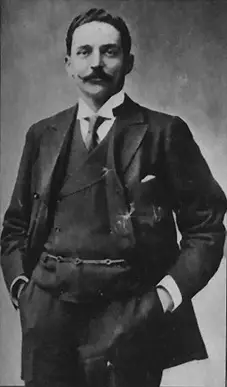
White Star Line President
Bruce Ismay
At this point in his testimony, Bruce Ismay urged Lowe saying "Give us what you said…I have no objection to his giving it. It was not very parliamentary." At first Lowe, upon Ismay's instruction, wrote the "inappropriate" word on a piece of paper that handed to the Inquiry chairman. The word was "hell."
Lowe explained that it was:
"in the heat of the moment... Because he was, in a way, interfering with my duties, and also, of course, he only did this because he was anxious to get the people away and also to help me...told him, "If you will get to hell out of that I shall be able to do something…He did not make any reply. I said, "Do you want me to lower away quickly?" I said, "You will have me drown the whole lot of them." I was on the floor myself lowering away."..He was at the ship's side, like this [indicating]. This is the ship - he was hanging on the davit like this [indicating]. He said, "Lower away, lower away, lower away," and I was slacking away just here at his feet [indicating]…He walked away; and then he went to No. 3 boat.(US Inquiry, Day 5)
Second class passenger Charlotte Collyer quickly noted the young, energetic junior officer: "Mr Lowe was very young and boyish-looking, but somehow he compelled people to obey him. He rushed among the passengers and ordered the women into the boat. Many of them followed him in a dazed kind of way, but others stayed by their men. I could have had a seat in that second boat, but I refused to go. It was filled at last and disappeared over the side with a rush. (Washington-Post Semi-Monthly Magazine 26 May 1912 courtesy "On Board RMS Titanic," by George Behe)
It is also possible that during the loading of lifeboat no.5 Lowe realised the seriousness of the situation and it was then that he quickly returned to his cabin to retrieve his firearm - a Browning automatic.
This is based on the evidence of First class passenger Mr Charles Emil Henry Stengel - "I saw two, a certain physician in New York and his brother, jump into the same boat my wife was in. Then the officer or the man that was loading the boat, said "I will stop that. I will go down and get my gun." He left the deck momentarily and came right back again. Afterwards I heard about five shots; that is while we were afloat. (US Inquiry)
First Officer William Murdoch and Third Officer Pitman were also present during the loading of no.5 - Murdoch would not get his gun until later in the evacuation when the senior officers met in his cabin. Pitman took command of lifeboat no.5, so would be unlikely to have returned to his cabin. So it is logical that the officer Stengel refers to is Lowe, who was responding to disruption at no. 5. According to the book Triumph and Tragedy, First Class passenger Dr. H W. Frauental decides the time is right to join his wife in the boat, and with his brother, jumps into the boat as it is lowered away. In doing so, he dislocates two ribs of Mrs. Annie May Stengel, already in the boat, and knocks her unconscious.” (Triumph and Tragedy p.150 (7.)). It is possible this event prompted Lowe to get his gun.
Lowe's Personal Revolver
During the Senate Inquiry, Lowe pointedly said: "I first of all went and got my revolver...you never know when you will need it. "(US Inquiry, Day 5). That a junior officer had his own personal revolver was never questioned. Only the senior officers were issued with White Star Line guns, which were Webley pistols (for more information check here).
As for the exact type of gun, Lowe later referred to it as a Browning automatic: "I put in my pocket and put the safety catch on, because it is a Browning automatic...It is an automatic. I think it carries eight." (US Inquiry)
As for the exact model of revolver it has been pointed out that it was likely a "semi-automatic" and may have been the Browning Model 1910 or the 1900. Both models shot the 32 acp (centerfire pistol cartridge). It may also have been the Colt Model 1903 hammerless (32 acp) which was designed by Browning. The other possibility is it was the Baby Browning Model 1906 in 25 acp.
A 1900 semi-automatic Browning revolver.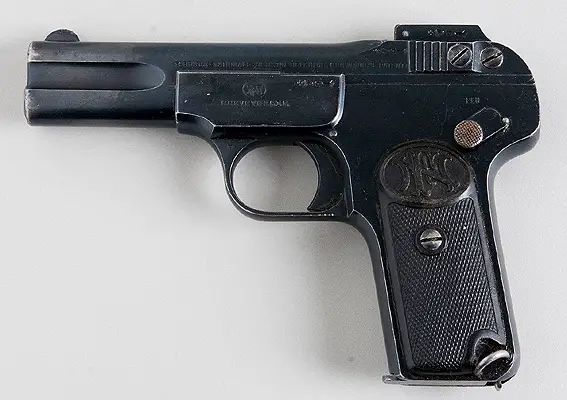
(Click image to enlarge)
12.55am Lifeboat no.3 and rockets
Shortly after no.5, Lowe was at lifeboat no.3 the next one on the starboard side. It is also when Lowe remembers seeing the first distress rocket fired. First Officer Murdoch "was there up to the finishing of No. 3." Ismay was also there - "I distinctly remember seeing him alongside of me - that is, by my side - when the first detonator went off. I will tell you how I happen to remember it so distinctly. It was because the flash of the detonator lit up the whole deck, I did not know who Mr. Ismay was then, but I learned afterwards who he was, and he was standing alongside of me.". In fact, the rockets were "incessantly going off; they were nearly deafening me.".(US Inquiry, Day 5)
Lifeboat no.3 ended up leaving with only 32 occupants, and Lowe explained that it was due to a lack of passengers:
"There did not seem to be any people there...Those that were there did not seem to want to go. I hollered out, "Who's next for the boat?" and there was no response…There was a little knot of people on the forepart of the gymnasium door.(US Inquiry, Day 5)
Lowering no. 3 Lowe said "I was standing at the side of the ship watching the after end." (US Inquiry, Day 5)
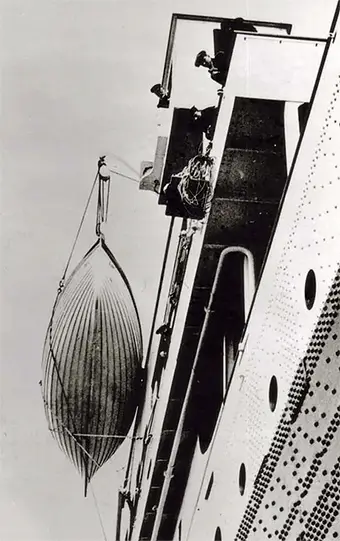
Emergency cutter lifeboat no.1 as seen from below in
Queenstown, Ireland, April 11th, 1912."
1:05am Emergency boat (no.1)
But when it came to low numbers of occupants, that record would be set by Lowe's next lifeboat, and the final one on the starboard side - the emergency cutter, lifeboat no.1. It departed with a total of 12. When questioned about this Lowe responded: "I do not know how many there were. I took everybody that was there; that is all I know..I cleared the deck…There were no people left on the starboard deck. (British Inquiry). And it was not for the want of trying - Lowe even had the lifeboat stop at A deck during the lowering to see if there was anyone else there: "I stopped the lowering of the boat at A deck, and told the men to have a look there, and they saw nobody." (British Inquiry). He had also checked once the boat reached the water: "I remember asking, I remember I hollered down from the boat deck to the water and said, "Who is that in the emergency boat?" And I could not quite hear what he said. (US Inquiry, Day 5)
It was also at lifeboat no.1, which was next to where Fourth Officer Boxhall was firing the distress rockets, that Lowe noticed the 'mystery ship.': " As I was getting the emergency boat ready, No. 1, Mr. Boxhall was firing the detonators, the distress signals, and somebody mentioned something about a ship on the port bow, and I glanced over in that direction casually and I saw a steamer there." (British Inquiry) He also wrote in his sworn account: "As I was putting over the starboard emergency boat somebody mentioned something about a ship on the port bow. I glanced in that direction and saw a steamer showing her red light about 5 miles to the northward of us. At this time Fourth Officer Boxhall was firing off signals of distress, and we also Morsed to the ship by electric Morse lamps on the bridge. When I had got these boats tied together I still saw these [lights] in the same position, and shortly afterwards she seemed to alter her position and open her green. I knew a few minutes afterwards all the lights went out, and I did not see any more lights until I saw the lights of the Carpathia. (Harold Lowe's sworn disposition to the British Consulate, 1912, courtesy "On Board RMS Titanic," by George Behe) In a latter account he said that when he came on deck the weather was still the same, dark on the water and clear above. He saw a ship some four miles away after the collision. ("The Third Titanic Inquiry - Ryan v. OSNC Transcript of Precis Law Report," Encyclopedia Titanica)
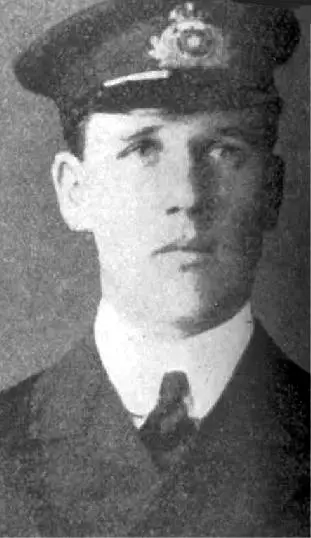
James Moody in White Star Line uniform.
Moody and lifeboats 16 and 14
Having finished with the first four starboard lifeboats (7,5,3,and 1) Lowe then crossed over to the portside, perhaps for the simple reason there were more people there: "Because they seemed to be busy there." (British Inquiry)
He joined fellow junior officer, Sixth Officer James Moody, at lifeboats 14 and 16:
I next went across the deck…To the other side, that is, the port side, and I met the sixth officer, [James] Moody, and asked Moody, "What are you doing?" He said, "I am getting these boats away." So we filled both 14 and 16 with women and children...I did not fill 16; Moody filled 16."(US Inquiry, Day 5)
See also...
Next... Lifeboat 14